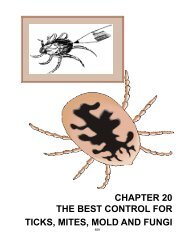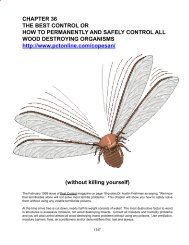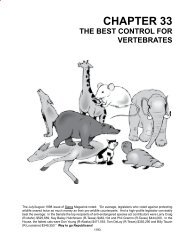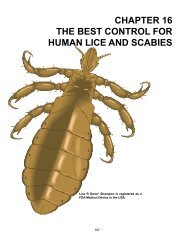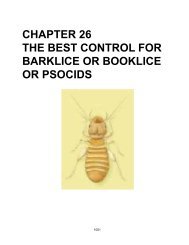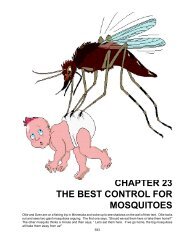CHAPTER 11 - The Best Control 2
CHAPTER 11 - The Best Control 2
CHAPTER 11 - The Best Control 2
- No tags were found...
Create successful ePaper yourself
Turn your PDF publications into a flip-book with our unique Google optimized e-Paper software.
ight red and cover them with petroleum jelly.Red Food Dye - Will kill many insects including medflies when they ingest leaves and other food materials thathave been sprayed with diluted dye. <strong>The</strong>y die from the ammines.Red Lights - let you get close enough to roaches, carpenter ants and other nocturnal pests to “pet” them, sosimply vacuum them up. Put corn starch (1 tablespoon) in a dry vac or 4 oz. of enzyme cleaner in a quart ofwater in a wet vac to kill the pests you vacuum up.Red Packing Envelopes - with glue on the back can be stuck on a wall and/or behind an appliance, etc. on a45 o angle. Stick open and baited with light Karo syrup and a ½% sodium borate bait.Reflective Tape - will scare away birds.Refuge Habitats - Just one more alternative pest management practice. Allows for growth of beneficial organisms.Registered Pesticide (Poisons) - is just another oxymoron for many reasons. Often only 1% or less of the poisoncompound/formula is tested or extended rather than registered. Other times different federal agencies lookat the poison from far different perspectives and issue completely opposite “warnings” and “directions”. Oftenthe exact same product is a poison for one use and a non-poison for the next use, e.g., disodium octoboratetetrahydrate or sodium borate; when sold as a wood fire retardant, Poly-bor ® , it is not a registered pesticide;when it is sold as a wood treatment for wood destroying organisms, Tim-bor ® , it is a registered pesticide; whensold as a fertilizer, Solu-bor ® , it is not a registered pesticide; when it is sold to mop floors, Mop-Up ® , it onceagain magically becomes a registered pesticide poison. Confused? <strong>The</strong> Author is too; there, obviously, is nologic behind registration.Regular Maintenance Checks - Walk around the entire area to inspect previous infestation sites and to ensureall pest-proofing measures are still intact. Reduce moisture and many pest problems are also reduced.Relative Humidity - Reduce the relative humidity and you control many pests, e.g., dust mites, roaches andbed bugs. Reduce moisture and many pests problems will also be reduced.Remove Plant Debris - and you help to remove disease and pest problems.Repair and Replace - Preventative and ongoing maintenance programs prevent future pest invasions and, ifdone properly, prevent costly major repairs.Repellent and/or Deterrent Chemicals - can be used to protect people, plants and/or animals from parasitesand predators.Repellent Planting - Many plants naturally repel pests. Put some in a blender with some water and some soapto make your own repellent spray or scatter their leaves around to repel pests. Garlic repels most insects.Research - Every day the Author learns another alternative contol; research must be constantly performed.Resistance - <strong>The</strong> ability of the pest to become immune to a particular pesticide poison or microorganism to becomeimmune to an antibiotic. At some point all synthetic pesticides/medicines will fail to control pest/infectionproblems. Resistance is the natural, inherited ability of a living organism to adapt in order to survive a particularpesticide/mrdicine that would normally give effective (but not safe) control. As early as 1993 greater than 504insect species were known to be resistant to at least one formulation of insecticide and at least 17 species ofinsect species are resistant to all major classes of insecticide. 150 fungi and other plant pathogens are resistantand several plant pathogens are resistant to nearly all systemic fungicides used against them. Five kinds ofrats are known to be resistant to the chemicals that are used against them. Resistance to herbicides have beendocumented in over 100 weed biotypes and 84 species (Cate and Hinkle 1994).<strong>The</strong> green peach aphid, Myzus persicae (Homoptera: Aphidae), is resistant to more insecticides than any otherinsect. Two other agricultural pests that are notoriously resistant, the Colorado potato beetle, Leptinotarsa449



